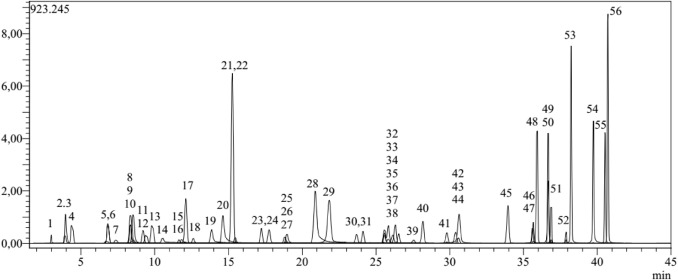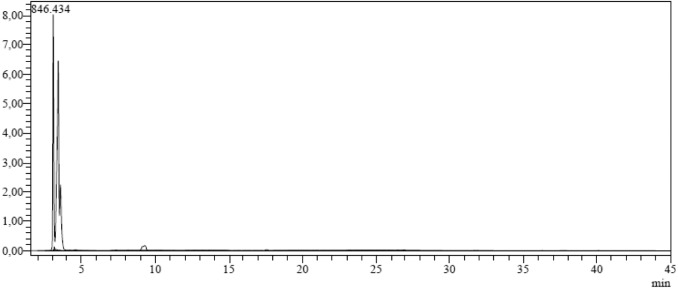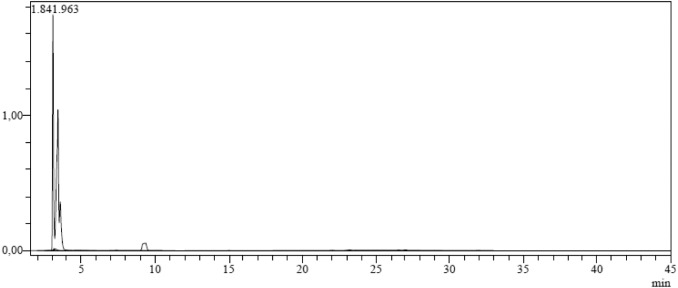Title: LC-MS/MS phenolic composition of peach (Prunus persica (L.) Batsch) extracts and an evaluation of their antidiabetic, antioxidant, and antibacterial activities
Journal: South African Journal of Botany
Published: 2022
Background
Peach (Prunus persica) is a globally cultivated stone fruit known for its sensory properties and health benefits, including its antioxidant, antidiabetic, and antibacterial potential. Despite being rich in phenolic compounds, the phenolic profiles and bioactive properties of peaches, particularly the fresh red peach from Turkey, have not been extensively studied. The study aimed to analyze the phenolic content of peach extracts using LC-MS/MS and to evaluate their antioxidant, antibacterial, and antidiabetic activities. The research focused on ethanol, methanol, and hexane extracts of fresh red peaches, revealing significant antioxidant, enzyme inhibitory, and antibacterial properties, particularly in the ethanol extract. These findings suggest the potential of peach extracts as ingredients in food-derived antidiabetic and antibacterial formulations.
Materials & Methods
Plant Material
Fresh red peach cultivars were obtained from Mersin, Turkey, in 2018.
Reagents
Chemicals for LC-MS/MS analysis were sourced from Sigma-Aldrich (Germany), including chloroform, hexane, methanol, ammonium formate, ethanol, formic acid, and acetonitrile. Other reagents such as Folin-Ciocalteu, sodium carbonate, and gallic acid were purchased from Merck KGaA (Germany) and Fluka (USA). Analytical-grade chemicals were used throughout the study.
Bioactivity Assay Preparation of Extracts and LC-MS/MS Analysis
Peach pulp (15 g) was homogenized with 150 mL of solvent (ethanol, methanol, hexane), sonicated for 45 minutes, and centrifuged. The supernatant was discarded, and the extraction was repeated twice. The solvent extracts were evaporated and stored at −20°C after lyophilization.
Equipment and Analytical Conditions
- LC-MS/MS Analysis:
The study used an ultrahigh-performance liquid chromatography (UHPLC) system (Shimadzu-Nexera model) coupled with a tandem mass spectrometer. The chromatographic conditions were optimized using an Agilent Poroshell 120 EC-C18 column. The gradient elution system used water and methanol with ammonium formate and formic acid additives. The Shimadzu LCMS-8040 model tandem mass spectrometer with electrospray ionization (ESI) was employed for mass spectrometric detection.
Total phenolic content was measured spectrophotometrically using the Folin-Ciocalteu method, and results were expressed as gallic acid equivalents (GAE).
Inhibitory Assays on α-Glucosidase and α-Amylase
- α-Glucosidase Inhibition: The inhibition of α-glucosidase was measured by mixing the enzyme with the extract and p-nitrophenyl-α-D-glucopyranoside (pNPG), followed by absorbance measurement at 405 nm. Acarbose was used as the positive control.
- α-Amylase Inhibition: The assay involved incubating α-amylase with starch solution and extracts, then measuring absorbance at 540 nm after adding dinitrosalicylic acid. Acarbose served as the positive control.
Determination of Antioxidant Activity
- DPPH Method: Free radical scavenging activity was measured by mixing the extract with DPPH, and the absorbance was recorded at 515 nm.
- FRAP Method: Antioxidant activity was determined by reacting the extract with a FRAP solution, and the absorbance was measured at 593 nm.
Antibacterial Activity
The antibacterial effect was determined using the disk diffusion method. Ethanol, methanol, and hexane extracts were applied to sterile filter paper discs. The inhibition zone was measured after 24 hours of incubation at 37°C. Ampicillin was used as the positive control.
Statistical Analysis
Data from enzyme inhibition, antioxidant, antibacterial assays, and total phenolics were expressed as mean ± SD. The statistical significance was assessed using the Student's t-test (p < 0.05).
Results
LC-MS/MS Analysis:
- Methanol Extract: 12 metabolites identified, including quinic acid, fumaric acid, aconitic acid, protocatechuic acid, chlorogenic acid, rutin, isoquercitrin, hesperidin, astragalin, nicotiflorin, quercetin, and amentoflavone.
- Ethanol Extract: 13 metabolites identified, with salicylic acid found in ethanol but not methanol extract. Quinic acid was the most abundant phenolic compound in both extracts.
- The ethanol extract showed a higher concentration of several compounds like chlorogenic acid, rutin, isoquercitrin, and quercetin compared to the methanol extract.
 Fig. 1. TIC (Total Ion Chromatogram) chromatogram of standard phenolic compounds
Fig. 1. TIC (Total Ion Chromatogram) chromatogram of standard phenolic compounds
 Fig. 2. TIC chromatogram of fresh red peach methanol extract analyzed by the LC–MS/MS.
Fig. 2. TIC chromatogram of fresh red peach methanol extract analyzed by the LC–MS/MS.
 Fig. 3. TIC chromatogram of fresh red peach ethanol extract analyzed by the LC–MS/MS.
Fig. 3. TIC chromatogram of fresh red peach ethanol extract analyzed by the LC–MS/MS.
Total Phenolic Content:
- The ethanol extract exhibited the highest total phenolic content (105.1 mg GAE/g), significantly higher than methanol and hexane extracts.
- The phenolic content ranged from 0.85 to 105.1 mg GAE/g across different extracts.
Antioxidant Activity:
- Both FRAP and DPPH assays confirmed that all extracts exhibited antioxidant activity. The ethanol extract showed the highest antioxidant activity, with 54.1 mM TE/g (FRAP) and 66.5 mM TE/g (DPPH).
- Hexane extract showed the lowest antioxidant activity.
Anti-α-glucosidase and Anti-α-amylase Activity:
- Both methanol and ethanol extracts inhibited α-glucosidase and α-amylase enzymes, with ethanol extract showing the strongest inhibition.
- The IC50 for ethanol extract was 2.65 mg/mL (α-glucosidase) and 1.45 mg/mL (α-amylase), which was more potent than methanol extract.
Antibacterial Activity:
- Ethanol extract exhibited significant antibacterial activity against E. coli (14.9 mm) and S. aureus (18.8 mm), while methanol extract showed weaker effects.
- Hexane extract showed no antibacterial activity.
- Ethanol extract was more effective than the standard antibiotic, ampicillin, against E. coli but slightly less effective against S. aureus.
Reference
- Gedük, Aysun Şener, and Selma Atsız. "LC-MS/MS phenolic composition of peach (Prunus persica (L.) Batsch) extracts and an evaluation of their antidiabetic, antioxidant, and antibacterial activities." South African Journal of Botany 147 (2022): 636-645. https://doi.org/10.1016/j.sajb.2022.02.026




